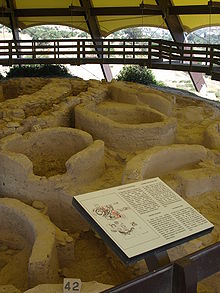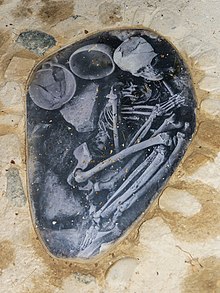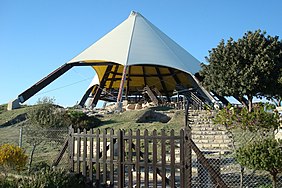Tenta, Cyprus
( PPNB | |
| Cultures | Cypriote Aceramic Neolithic |
|---|---|
| Site notes | |
| Discovered | 1940 |
| Excavation dates | 1947–1984 |
| Archaeologists | Porphyrios Dikaios |
| Management | Cyprus Department of Antiquities |
| Public access | yes |
Tenta, also referred to as Kalavasos-Tenta or Tenda, is an
The earliest occupation at the
Six seasons of excavation in Tenta occurred from 1947 to 1984.[3][6] The obtained data is of interest to studies of cultural change in Prehistoric Cyprus because Tenta's architectural remains, artefacts, human burials, flora and fauna have been "virtually unchanged for two millennia, suggesting that there was considerable continuity in social organisation as well as technological and economic practices."[3]
Today, the site is open to visitors (with entrance fee), and protected by a characteristic, modern cone-shaped roof.[7] The roof is considered a local landmark,[8] and the site a popular tourist attraction.[9]
Background and name
The
According to local tradition, the name of the location refers back to 327 AD when Saint Helena, mother of Constantine I, stayed there in a tent (Greek: Tέντα).[1] Helena supposedly pitched her tent after walking up the Vasilikos valley (Greek: Βασιλικός), vasilikos meaning "royal place or land".[1][6]
Excavation history
The archealogical site of Tenta was first reported by Porphyrios Dikaios in 1940 when artefacts were discovered during the construction of a mining railway line.[11] In 1947, Dikaios undertook a two-week archaeological excavation focused 25 metres south of the summit of Tenta.[2] Eleven locals and several students from Brandeis University were employed to assist with the excavation.[11] A detailed report of the excavation was never published, but a plan of the excavation was released in 1960, which showed a trench being excavated approximately five metres below and adjacent to a curvilinear wall.[3][11]
Since many sites of Cyprus had only been fleetingly explored, Vassos Karageorghis, the Director of the Department of Antiquities of Cyprus, worked with Ian Todd, who had previously assisted in numerous excavations in Turkey and Iran, to direct the Vasilikos Valley project which included five seasons of excavation in Tenta between 1976 and 1984.[2][11] The project was sponsored by Brandeis University and funded by the National Science Foundation.[12]
To locate sites, Todd walked nineteen different transects across the valley from east to west – from the Kalavasos Dam to the coast. Each transect was positioned equidistant from each other.[3] Problems of the archaeological field survey in Cyprus include erosion as many sites were situated on different gradients, which often affects the estimation of the size of a site as well as makes it more challenging for surveyors to find where artefacts are located.[2][10] Furthermore, aggradation was also considered to be a potential problem impacting the discovery of sites due to the increase in land elevation.[3][10]
Although the excavations ended in 1984, details about the findings were published as late as 2005.[13]
Architectural remains

All structures discovered in Tenta are curvilinear and thus from the
Artefacts
Approximately one thousand man-made artefacts
Human burials

Fourteen human burials containing eighteen individuals were excavated at Tenta.[6][19] The eighteen skeletons were buried in contracted positions and positioned to the internal house walls, within oval pits not accompanied with any gifts or offerings, just beneath the floors or outside the structures.[6][20] The burials include adults, children and infants buried separately, except the remains of four infants buried together in one pit.[6]
The average age at death for males and females was 30.5 years and 36.5 years respectively.[6] This six-year gap between the sexes may be due to limitations of a small sample size as well as poor preservation and age averaging techniques, especially due to the differences in neighbouring Neolithic settlements in which the longevity of males is greater than females.[21] Furthermore, the average height for males and females was 162.9 centimetres (5 ft 4.1 in) and 153.8 centimetres (5 ft 0.6 in), respectively.[3][6] Analysis of the skeletons' teeth suggest that the inhabitants had generally good dental health as well as a diet sufficient in protein and carbohydrates.[13] This is due to the inhabitants' main diet consisting of plants as well as domesticated or hunted animals like fallow deer, pig and cattle.[22] Moreover, analysis of the eighteen skeletons determined that the inhabitants of Tenta may have suffered from hemolytic anemia and iron-deficiency anemia, as well as having practiced artificial cranial deformation due to 11.1% of them having their skulls bound.[13] Such practices were also common in the neighbouring Neolithic settlement of Khirokitia, and also during later periods in Cyprus such as the Late Bronze Age.[6]
Botanical remains
The botanical remains from Tenta revealed the subsistence practices in the Aceramic Neolithic period.
The distribution of botanical remains as well as the fire pits and hearths inside and outside the architectural remains were examined and compared to neighbouring Neolithic settlements.[13] It was discovered that more hearths and fire pits were outside and between buildings than inside them, suggesting that the cooking in the period was conducted outside.[25] Two hearths from the site revealed that civilians had gathered wild resources for cooking such as fig, pistachio, grape, olive and plum, but the analysis of the botanical remains did not indicate the specific cooking process or storage practices in the Aceramic Neolithic period.[13][25]
Faunal remains
From the excavations at Tenta, 2817 faunal bone fragments were recovered.[13] As shown in the table below, the majority of bone fragments (99.7%) were from deer, pig and caprinae (sheep and goat), which highlights that the civilians of Tenta predominately surrounding these mammals coupled with the remaining 0.3% of fragments being cat, fox and rodent.[26] From epiphyseal plate data obtained from the faunal remains, it was found that 72% of deer, 28% of pig, 60% of caprinae were culled as adults.[26] A collection of antlers from deer were also found intact inside three buildings and believed to have been possibly showcased by villagers in Tenta as an achievement of their hunting.[26][27]
The process of recovering the faunal remains involved sieving excavated deposits through all 1 cm, 5 mm and 3 mm meshes.
| Faunal bone fragments | Number | Percentage (%) |
|---|---|---|
| Deer | 1095 | 38.9 |
| Pig | 924 | 32.8 |
| Caprinae | 789 | 28.0 |
| Cat | 4 | 0.1 |
| Fox | 3 | 0.1 |
| Rodent | 2 | 0.1 |
Graphs are unavailable due to technical issues. There is more info on Phabricator and on MediaWiki.org. |
Numbers and percentages of identified faunal bone fragments from Tenta.[13]
Protective shelter
In 1994 to 1995,
References
- ^ a b c d e f g h i j k "Department of Antiquities - Archaeological Sites". Ministry of Transport, Communications and Works. Retrieved 2022-05-09.
- ^ JSTOR 41726235.
- ^ S2CID 231656804.
- S2CID 165999521.
- JSTOR 530200.
- ^ a b c d e f g h i j k l m n o "Καλαβασός / Kalavasos - Tenta". www.kalavasos.org. Community Council of Kalavasos. Retrieved 20 July 2022.
- ^ "Kalavasos – Tenta Archaeological Site". VisitCyprus. Deputy Ministry of Tourism. Retrieved 21 July 2022.
- ^ ISSN 1350-5033.
- JSTOR 1357781.
- ^ JSTOR 40960372.
- ^ JSTOR 529451.
- ^ "Kalavasos-Tenta". History Hit. Retrieved 2022-05-09.
- ^ ISBN 9789170811395.
- ^ S2CID 219021742.
- JSTOR 529656.
- JSTOR 529532.
- ISBN 978-94-007-4634-3, retrieved 2022-05-10
- ^ a b "Kalavasos Tenta - Archaeological Site". Cyprus Island. 2017-03-15. Retrieved 2022-05-09.
- S2CID 161426067.
- S2CID 161732720.
- ISSN 0043-8243.
- JSTOR j.ctt1s4751q.
- ISSN 0153-9345.
- OCLC 707054176.
- ^ S2CID 129727157.
- ^ ISSN 0007-4217.
- S2CID 147617335.
- S2CID 162533858.
- ^ )
- ^ S2CID 163921012.
- S2CID 41361892.


